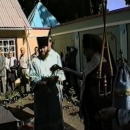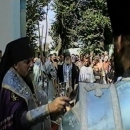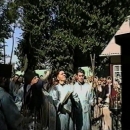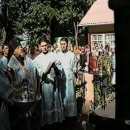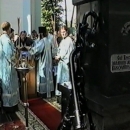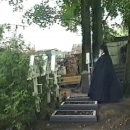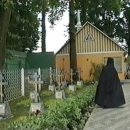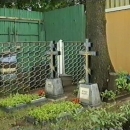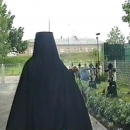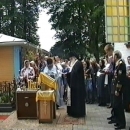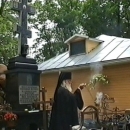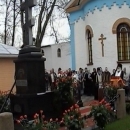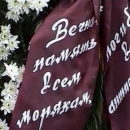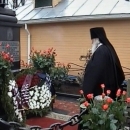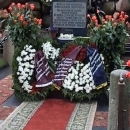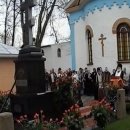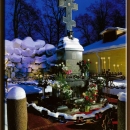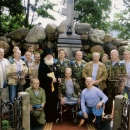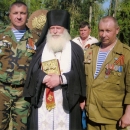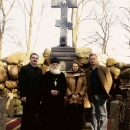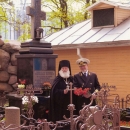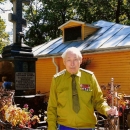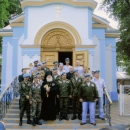The founding of the Memorial
In Summer 1998 during digging works on the territory of the former cemetery a huge granite cross remaining in good condition was found. In 2000 the cross was solemnly blessed by His Eminence Alexander, Metropolitan of Riga and all Latvia, and installed in the inner court of the church as a symbolic cross on the common grave of everyone buried on that place.
Thus, by God’s intent and with blessing of most holy Archbishop Alexander, thanks to the efforts of the priest, parishioners and many benefactors, a rarely beautiful memorial complex was constructed on the place where many thousands of Christians belonging to orthodox and other denominations were buried. This memorial complex is distinguished by its artistic design and is a unique landmark of Latvian orthodox architecture.
The base of the memorial holds a capsule containing scrolls with the names of the benefactors and authors of the memorial complex.
The Memorial
In the centre of the memorial complex there is the homage cross. It is a sign in memory of the poly-confessional cemetery that once existed on this place and of all the departed orthodox Christians.
On the front side of the memorial is an inscription saying:
To all orthodox Christians departed in all ages.
Give rest eternal, in blessed falling asleep, O Lord, to the souls of
all those buried here, died in the sea and killed in battles
and make their memory to be eternal!
On top of the inscription is a picture of Christ walking on waters but on the uppermost part of the cross – icon of Theotokos (Mother of God). On the reverse side of the memorial is a picture of tall-ship and inscription saying:
Anchor is the hope for a ship in the sea
Faith is the anchor for a man on earth
The ship, sailing through the sea of life, is a symbol of the Church of Christ. A bit lower is an inscription saying: “This cross was erected as a sign of God’s grace, upon the highest blessing” and blessed by His Eminence Alexander, Metropolitan of Riga and all Latvia.
To the right from the memorial cross lies a sea anchor, which is also symbolic: anchor, cross and the Holy Gospel are the essence of our earthly voyage through the sea of life. Anchor also symbolizes a common grave of all sailors died in the sea without burial and a cross on their graves. The memorial was erected in the year of the shipwreck of the Kursk nuclear submarine.
The memorial cross is surrounded by fence made of heavy anchor chains. On entering the memorial parishioners are greeted by icons of martyr priest St John of Riga (Pommers) and holy righteous Theodore (Ushakov), admiral of the Russian fleet, who were both pronounced saints almost at the same time.
The last part of the memorial is the Wall of Memory, which is an inclined wall made of large boulder stones.
From beneath the stones drops of water quietly flow – these are mother’s tears shed for all those buried here. The water flows down the slanting wall and into the common basin (a chalice). The brightness and colours of the illumination of the basin change, the “tears” shine bright and fade again, creating a feeling of unearthliness of the place, which is translated to every visitor, whether a parishioner, a pilgrim or just a tired traveler…
The wall is oval in shape, 9-meter-long, 4-meter-high and 3-meter thick, resembling an altar.
The stones are piled so that the biggest boulders are on top, and the smaller ones are held by mortar in the base. The spiritual meaning of it is that the higher one rises, the heavier their burden is.





